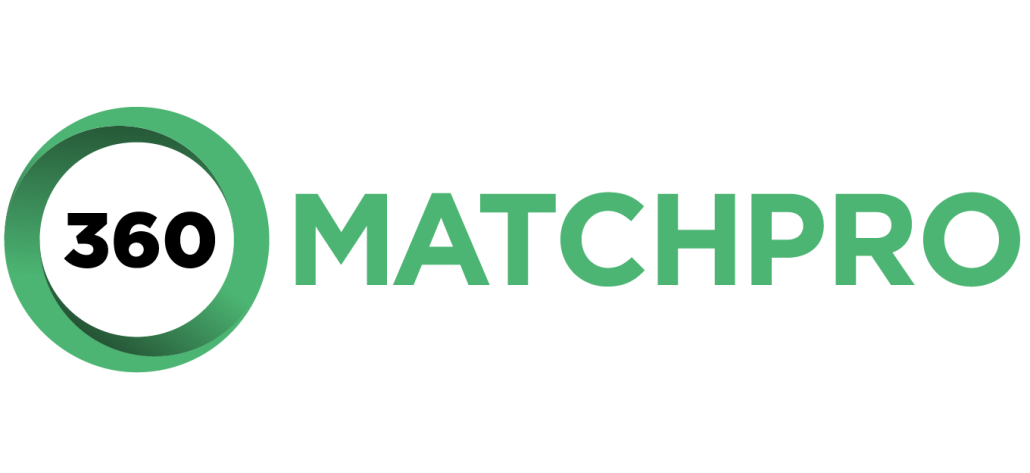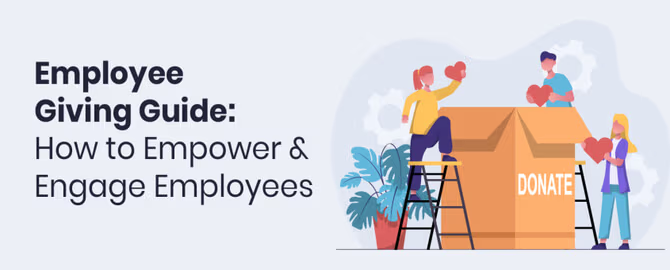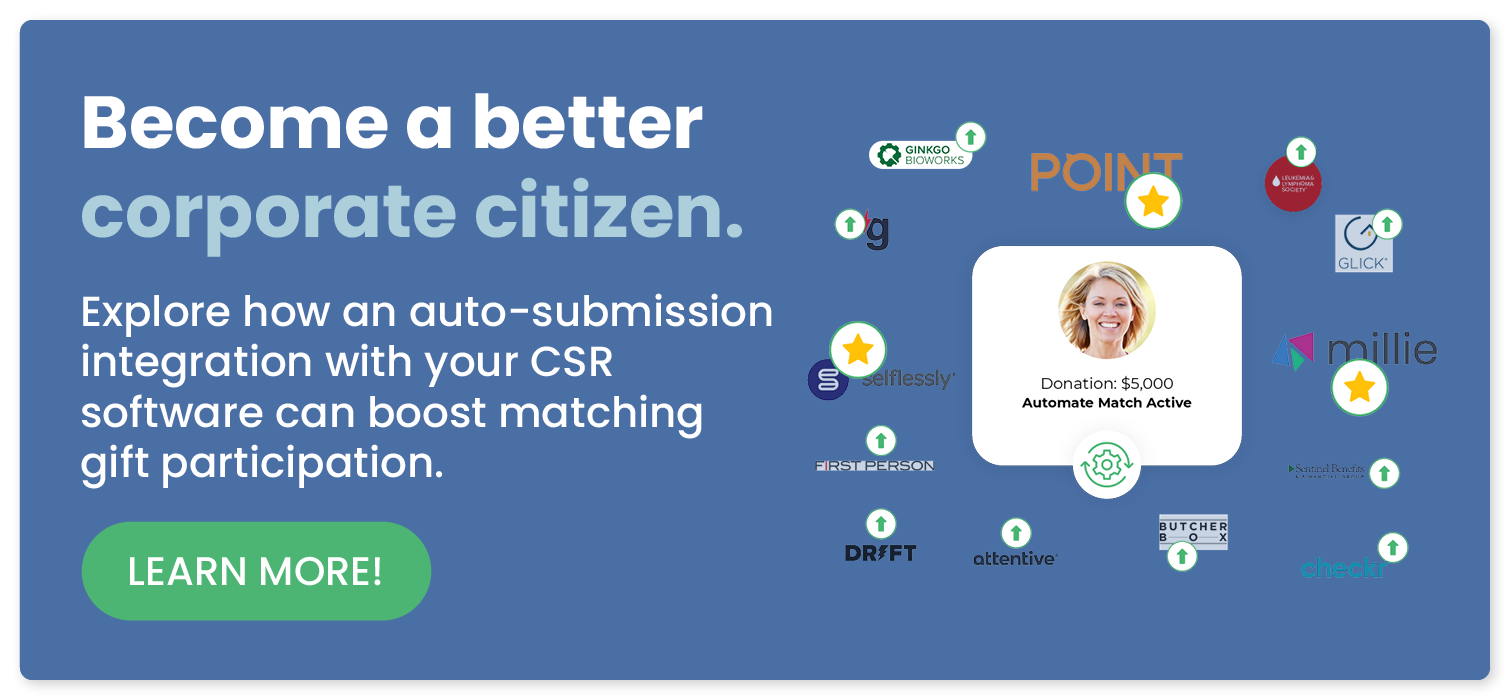Employee Giving Guide: How to Empower & Engage Employees
Employees care about more than just their salaries when choosing an employer. According to studies on workplace satisfaction, 71% of employees say they consider it imperative for their work culture to support giving and volunteering.
If you’re looking for new ways to engage your team members and boost employee retention, an employee giving program could be just what you need.
This guide will cover everything you need to know about employee giving, including:
- What is Employee Giving?
- What Are the Types of Employee Giving?
- What Tools do I Need to Start an Employee Giving Program?
- Employee Giving Benefits
- Top Employee Giving Programs to Be Inspired By
- How to Start Your Own Employee Giving Program
Employee giving programs allow you to connect with your staff and improve your community at the same time. To get started with your new employee giving program, let’s first define exactly what employee giving is. 
What is Employee Giving?
Employee giving, also known as workplace giving, is a type of corporate philanthropy program that empowers employees to give to the causes they care about through their workplace.
Employee giving can be a standalone philanthropy program or serve as part of a wider corporate social responsibility (CSR) strategy. For instance, your company might have an employee giving program and further conduct social good through additional nonprofit sponsorships and an energy conservation initiative for your office building.
What Are the Types of Employee Giving?
Employee giving comes in many forms. Depending on your company’s preferences and resources, you might offer the following programs:
- Matching gifts: Corporate matching gift programs involve your company matching employees’ monetary donations to nonprofits. After setting eligibility guidelines, your company would match qualified gifts at a 1:1 ratio, meaning you’d match an employee’s $25 donation with a $25 gift of your own to give the nonprofit $50 total. Some particularly generous companies match at a higher 2:1 ratio.
- Volunteer grants: Encourage employees to volunteer by offering monetary grants based on their volunteer hours. For example, you might give nonprofits your employees volunteer with $25 per hour volunteered. If the team member volunteered 20 hours, your company would donate $500 to that nonprofit. Some companies also offer volunteer time off (VTO) programs, or time off that’s meant to be used for volunteer opportunities.
- Paycheck deductions: Simplify giving for your employees by allowing them to set up recurring donations that come automatically out of their paychecks. If an employee wants to give $20 to their local animal shelter each month, your payroll system makes an automatic deduction and processes the donation without any input from the employee needed.
- Employee grant stipends: Instead of having employees donate their own money, give each employee a stipend to donate to their preferred nonprofit. For example, you might set aside $100 per employee each year for charitable donations.
Each type of employee giving has its own benefits, and some may suit your business better than others. If you’re unsure which program will resonate with your employees, consider sending out a survey or asking managers for feedback on which types of giving would interest team members. After all, these programs are a great way to show you appreciate employees’ efforts and interests outside the workplace.
What Tools Do I Need to Start an Employee Giving Program?
CSR software can help you successfully manage your employee giving program and boost team member participation. These platforms are designed to:
- Facilitate employee participation
- Help businesses manage grants
- Process automatic payroll deductions
- Simplify employee giving
- Track program outcomes
- Distribute donations to nonprofits
- Manage non-employee giving related CSR programs, like in-kind donations and disaster relief funds
Some CSR providers, like Seflessly and POINT, simplify the matching gift process even further by offering matching gift auto-submission. This cutting-edge technology allows employees to submit their match requests with just their corporate email address and the click of a button!
Check out this short video to see how it works:
Leveraging auto-submission can provide a number of benefits, including:
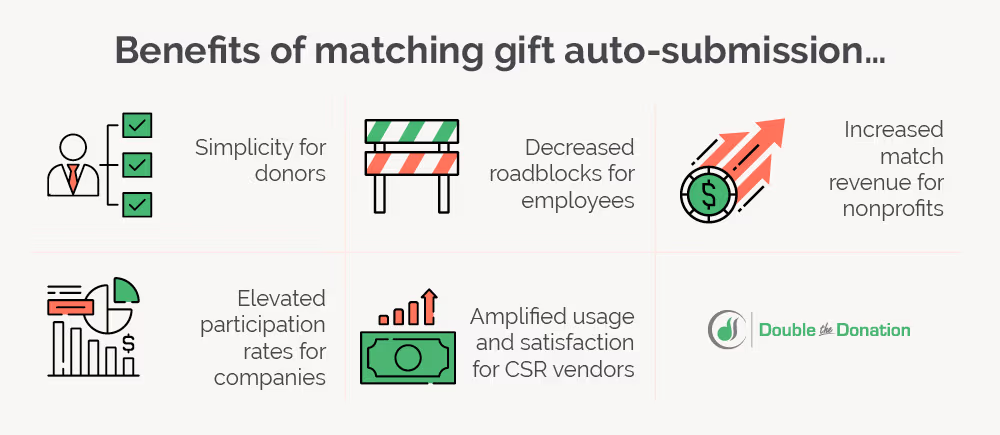
- Simplified giving process
- Decreased matching gift request roadblocks
- Increased match revenue
- Elevated matching gift program participation
- Amplified usage of CSR tools
Using any type of automation increases a nonprofit’s matching gift revenue by 61%, and auto-submission is expected to boost matched donations by an additional 80-200%. This means that using CSR platforms with auto-submission functionality greatly benefits nonprofits, employees, and your company.
Employee Giving Benefits
Starting an employee giving initiative at your business is a win-win-win for your company, your employees, and the nonprofits they donate to. Here’s a breakdown of how all of these stakeholders benefit:

Benefits for Companies
We’ve already touched on some ways your company benefits from employee giving programs, but let’s go into more detail about how these programs are so beneficial. With a robust employee giving program, your company can:
- Engage employees. Make your employees’ work more meaningful and boost engagement by empowering them to make a personal impact on their communities. Plus, by supporting your employees’ giving efforts, you’ll show them that you care about the same causes they do.
- Increase employee satisfaction and retention. Employees want to work for companies that share their values. By investing in employee giving, you’ll make employees happier and more likely to stay at your company long-term.
- Boost your company’s reputation. Employees aren’t the only ones who care about corporate social responsibility. According to Harvard Business School Online, 77% of consumers and 73% of investors are more motivated to spend money on companies committed to making the world a better place. Demonstrate your commitment to CSR with employee giving initiatives, and your company will strengthen its reputation.
Additionally, by regularly interacting with nonprofits through employee giving, your business can develop mutually beneficial relationships with these organizations. These relationships can lead to future marketing and outreach opportunities that further engage your employees and customers.
Benefits for Employees
In comparison to individual donations employees may make outside of work, structured corporate giving programs provide reminders and incentives to donate. This helps employees maintain regular giving habits and can boost their potential impact, such as by doubling donations through gift matching.
Along with increasing their charitable impact, employees experience benefits in the workplace. Employee giving programs help cultivate a positive company culture by showing employees that employers share their values. This leads to improved workplace relationships, increased trust in their employer, and higher retention rates.
Benefits for Nonprofits
The organizations your employees donate to, whether they’re nonprofits, universities, churches, or other organizations, benefit from robust employee giving programs. These include:
- Low-cost fundraising
- Increased donor engagement
- More resources to further their cause
- Potential to build a relationship with your business for future sponsorship opportunities
- Ability to make a greater impact on the community
Employee giving programs also allow nonprofits to receive more donations without asking their donors to give any more than they normally would. This keeps their relationships with supporters strong while increasing their capacity to help their communities.
Top Employee Giving Programs to Be Inspired By
Over 65% of Fortune 500 companies have employee giving programs, and each of them is unique. Explore a few of our favorite examples to see how your company can get creative with its program:
Microsoft
To incentivize employee giving, Microsoft sets its matching gift minimum as low as possible. As long as an employee donates at least $1 to an eligible nonprofit, the company matches it at a 1:1 ratio, with a maximum of $15,000 per employee per year. Plus, they have some of the highest levels of employee participation for a matching gift program at over 65%.
Microsoft also offers volunteer grants with no minimum number of hours required. Whether an employee volunteers for just one hour or 30 hours, Microsoft donates $25 per hour to the organization.
Disney
The Walt Disney Corporation stands out for its top-tier volunteer grant programs. Disney offers ongoing “EARS to You” grants which give up to $2,000 to nonprofits where employees regularly volunteer. Plus, the company gives out annual grants for “VoluntEARS of the Year.” These annual grants donate an additional $2,500 to organizations in recognition of exceptional volunteer service.
Along with volunteer grants, Disney matches employee donations of up to $25,000 at a 1:1 ratio.
Nike
Nike’s employee giving program is unique because, on top of their standard 1:1 match for eligible donations, the company offers an extra “triple match” for donations to sports-related organizations and nonprofits that are part of Nike’s Black Community Commitment.
For example, let’s say an employee donates to a nonprofit sports camp. In this scenario, Nike will match their donation at a 2:1 ratio instead of 1:1. If the employee donates $200, the company will give another $400 to the nonprofit, totaling $600!
How to Start Your Own Employee Giving Program
If you’re ready to follow these companies’ examples and reap the benefits of employee giving, follow these steps to start your company’s program:
1. Establish Guidelines
First, decide what type of employee giving program you’ll launch. You might offer matching gifts, paycheck deductions, volunteer grants, or all of the above. Again, think about which giving options your business’s employees will be most excited to participate in, and prioritize those.
Then, set all of the necessary guidelines for your programs. For example, for a matching gift program, you’d need to consider:
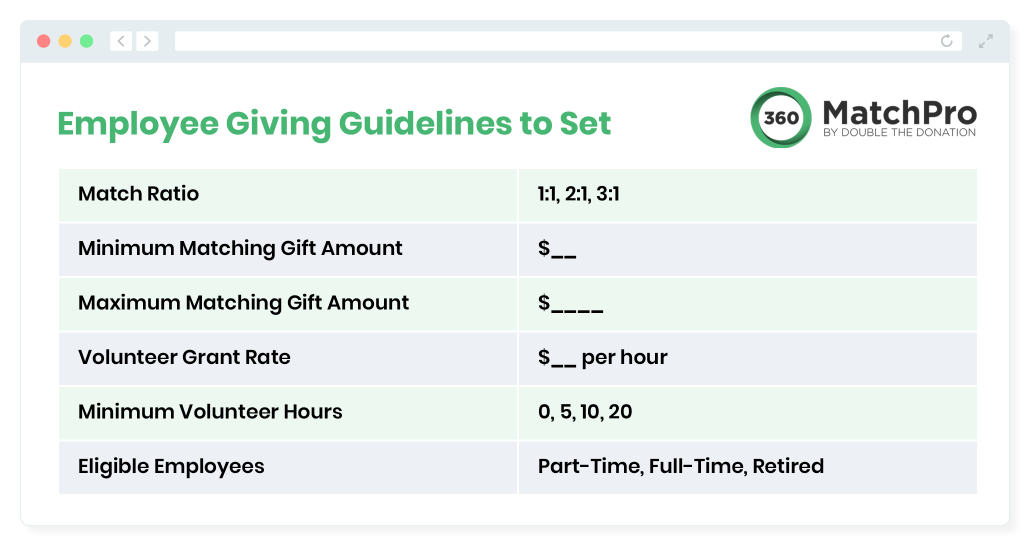
- Match ratio: Matching donations 1:1 means that your company will match employees’ donations exactly (employee donates $10, you donate $10). Meanwhile, a 2:1 ratio means you’ll contribute double the amount of the original donation (employee donates $10, you donate $20). Some companies also choose a 0.5:1 ratio, meaning you match only half of the employee’s gift (employee donates $10, you donate $5).
- Matching gift maximums and minimums: Incentivize participation and balance your budget for matching gifts with minimums and maximums. For example, you might match any gift above $10 and set an annual maximum of $15,000. In general, lower minimums and higher maximums yield higher participation rates. You can increase employee engagement up to 40% just by setting a maximum of more than $10,000.
- Volunteer grant guidelines: For volunteer grants, decide how much your company will donate per hour volunteered and how many initial hours employees need to volunteer to qualify. For example, you might require employees to volunteer 20 hours, and then make a flat donation of $200. Consider also setting a maximum grant amount per employee per year, such as $2,000.
- Eligible employee requirements: Determine which employees and types of organizations will qualify. Will retired or part-time employees be eligible for your employee giving programs? Will you match donations or provide volunteer grants for any nonprofit or exclude specific types of organizations, like churches and political groups?
Finally, outline submission guidelines and deadlines for submitting matching gift and volunteer grant requests. Commonly, deadlines for requests are at the end of each calendar or fiscal year. However, to accommodate year-end giving, you might extend the deadline into March or April for gifts made in November and December.
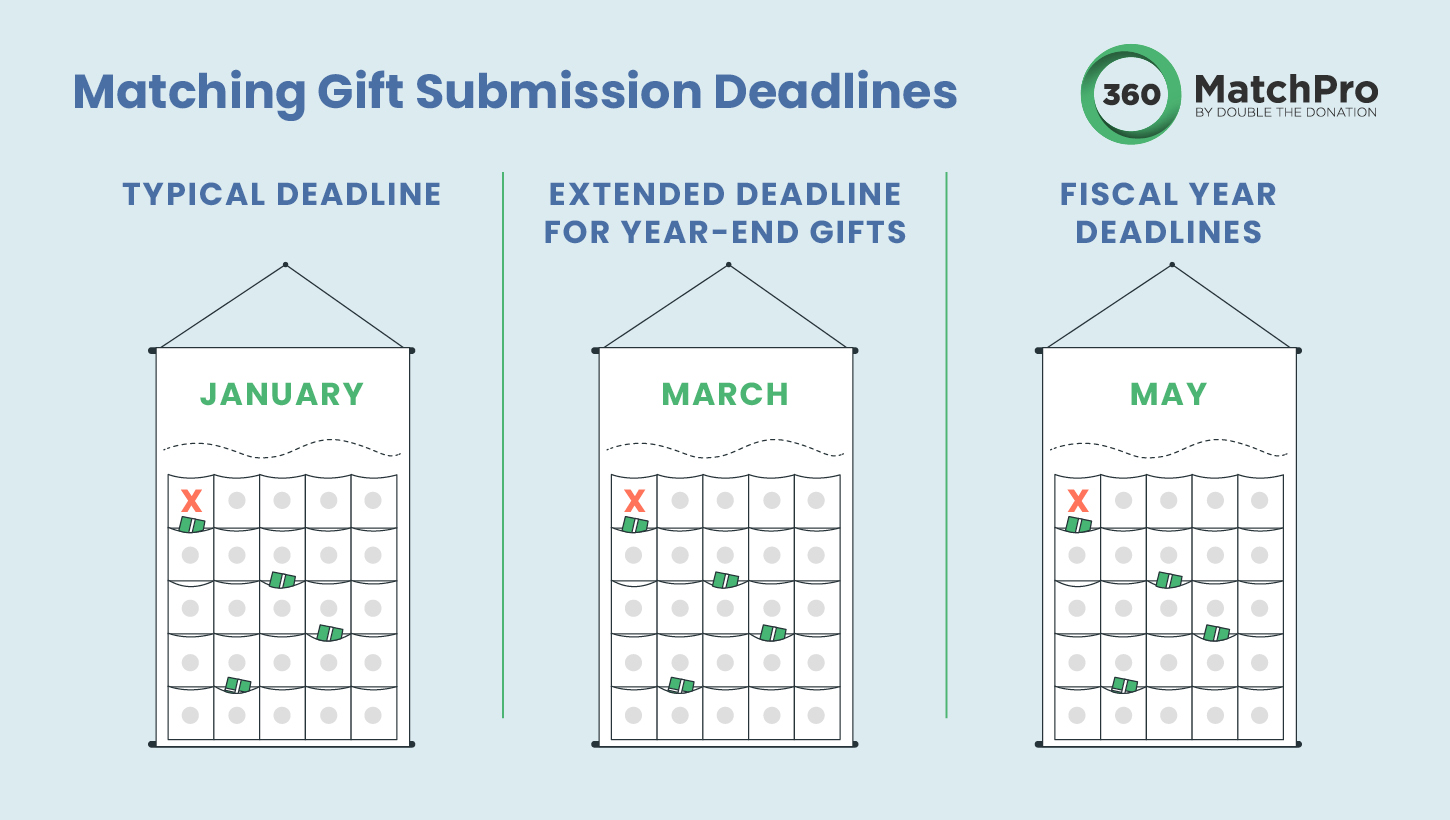
2. Promote Your Employee Giving Program
Next, spread the word about your new program! Let employees know the types of giving opportunities you offer, guidelines details, and participation benefits.
Promote your program widely and actively encourage employees to participate and give them the best employee giving experience possible. To promote the program, you might:
- Add employee giving guidelines to your employee handbook.
- Send out a company-wide email announcing the program.
- Email reminders about upcoming submission deadlines.
- Periodically remind employees of giving options during company-wide meetings.
- Incorporate employee giving into your onboarding process.
- Add your program to Double the Donation’s database for added visibility.
You can also motivate employees to participate with incentives. For example, you might start a holiday giving challenge encouraging employees to donate or volunteer during November and December. Whoever raises the most money can earn a prize.
Similarly, you might set up a matching donation challenge in which you promise to match donations to a particular nonprofit during a certain time frame or up to a certain amount.
3. Monitor the Program’s Success
Once your program is up and running, collect data such as employee participation rates, total funds donated, and total hours volunteered. This data will help you determine how successful your employee giving program is at engaging employees and making an impact.
After compiling this information, communicate it with your team members and the general public to demonstrate the positive impact your company is making. Communicate your results by updating employees and publishing a report at the end of the year. Include data like the number of organizations your employees donated to and volunteered at, along with how much your company donated in total that year.
You can also use this data to effectively recognize and thank the employees who participate in your program. What’s more, these insights can help make any necessary improvements in your program.
Additional Resources
Now that you know the basics, you’re ready to start engaging employees with your own employee giving program. Get your team together to discuss what employee giving could look like for you and the benefits of investing in the best tools to make it happen.
Want to learn more about employee giving and how to achieve success with your own program? Check out these resources:
- The Workplace Giving Guide for Corporate Changemakers. Learn about additional types of corporate giving initiatives and tips for implementing them successfully.
- Developing a Matching Gift Program: A How-To Guide. Excited to offer matching gifts to your employees? Use this guide to develop your own matching gift program.
- Small Businesses with Big Matching Gifts: Examples + Tips. Employee giving isn’t limited to big corporations! Explore these examples to see what employee giving programs can look like for small businesses.
